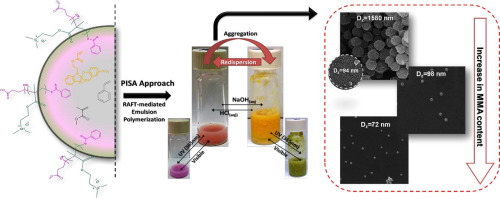Journal of Colloid and Interface Science ( IF 9.4 ) Pub Date : 2018-01-04 , DOI: 10.1016/j.jcis.2018.01.012 Fahimeh Khakzad , Ali Reza Mahdavian , Hamid Salehi-Mobarakeh , Mohammad Hossain Sharifian

|
Hypothesis
Surfactant-free emulsion polymerization has become favorable due to circumventing instability issues reasonably. Incorporation of an appropriate hydrophilic macroRAFT, could provide controlled in-situ self-assembly via copolymerization with hydrophobic monomers into polymer particles. So far, this approach has mostly been studied in dispersion systems and further studies are needed in emulsions. Beside the corresponding mechanistic studies, the prepared latex particles would potentially exhibit smart behaviors by choosing stimuli-responsive monomers.
Experiments
Poly(styrene-co-methyl methacrylate) latexes were prepared by utilizing pH-responsive polydimethylaminoethyl methacrylate as the hydrophilic segment through polymerization induced self-assembly (PISA). A systematic study on the effect of MMA amount, role of smart spiropyran ethylacrylate (SPEA) comonomer and the synthesized macroRAFT for inducing efficient assembly has been performed comparatively for the first time.
Findings
SEM and DLS analyses showed the effect of MMA content on the obtaining of spherical particles with bimodal or monodisperse size distributions in both series of samples. Kinetic studies through conversion measurements along with GPC analysis revealed that the incorporation of MMA and SPEA strongly affected the efficiency of in-situ self-assembly, particle formation and RAFT-controllability on molecular weights. Ultimately, acido/basochromism, pH-responsivity and UV-responsivity of the prepared latexes were verified and the results showed their facile and fast multi-responsivity.
中文翻译:

分步自组装方法制备含螺吡喃的多响应性聚苯乙烯-甲基丙烯酸甲酯共聚物
假设
由于合理地规避了不稳定性问题,无表面活性剂的乳液聚合变得有利。通过与疏水性单体共聚成聚合物颗粒,可以引入适当的亲水性macroRAFT,从而提供受控的原位自组装。迄今为止,该方法主要在分散体系中进行了研究,并且在乳液中还需要进一步的研究。除了进行相应的机理研究外,通过选择刺激反应性单体,制备的胶乳颗粒还可能表现出聪明的行为。
实验
聚(苯乙烯-甲基丙烯酸甲酯共聚物)胶乳是通过聚合诱导自组装(PISA),利用pH响应的聚甲基丙烯酸二甲基氨基乙酯作为亲水链段制备的。首次比较系统地研究了MMA用量,智能螺吡喃乙基丙烯酸酯(SPEA)共聚单体的作用以及合成的macroRAFT对诱导有效组装的影响。
发现
SEM和DLS分析表明,在两个系列的样品中,MMA含量对获得具有双峰或单分散尺寸分布的球形颗粒的影响。通过转化率测量和GPC分析进行的动力学研究表明,MMA和SPEA的结合极大地影响了分子量的原位自组装,颗粒形成和RAFT可控性的效率。最终,验证了所制备胶乳的酸/碱性变色,pH响应性和UV响应性,结果表明它们具有快速简便的多响应性。











































 京公网安备 11010802027423号
京公网安备 11010802027423号